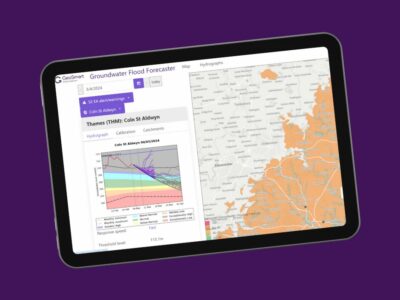Understanding groundwater flood risk
What is groundwater flooding?
Groundwater flooding occurs when sub-surface water emerges from the ground at the surface or into Made Ground and structures. This may be as a result of persistent rainfall that recharges aquifers until they are full; or may be as a result of high river levels, or tides, driving water through near-surface deposits. This can result in sewer flooding, damage to building fabric and disruption to economic activity due to the long duration of flood events. Whilst groundwater flooding is generally less hazardous to human health than surface flooding, it is more hazardous to property for a given flood depth, producing 2 to 4 times the damage to building fabric and greater disruption to economic activity due to the longer duration of flood events.
Characteristics of groundwater flooding
- Water flows to the surface or into basements, service ducts and other subsurface infrastructure rising up through floors or directly from the ground. This may be seen as diffuse seepage from the ground or an increase in spring flows. Slope stability may be affected.
- Flooding may last a long time compared to surface water flooding, from weeks to months. Hence property damage may be substantially higher and closures of access routes, roads, railways prolonged.
- Flooding may occur with a delay following periods of high rainfall. Emergent groundwater tends to be clear but potential contamination by sewers and brownfield sites poses additional hazards.
Groundwater flooding or a shallow water table prevents rainfall infiltration and increases the risk of surface water flooding. Lack of evidence for groundwater conditions may lead to incorrect analysis of overall flood causes.
Groundwater Flood Risk Mapping
The requirement to understand and map the extent of groundwater flood risk has arisen in response to well publicised groundwater flood events, in 2001 and 2013/14, the National Planning Policy Framework (NPPF) and the Law Society Practice Note concerning flood risk for property transactions. Enhancing resilience to extreme weather will be a significant aspect of future economic competitiveness, and mapping of groundwater flood risk areas provides important preparation support for emergency response, flood mitigation and land-use planning, as well as the assessment of climate change impact. The latest GeoSmart 5m Groundwater Flood Risk Map is the most sophisticated on the market providing detailed groundwater flood risk information on individual properties.
Contact us for more information on groundwater flood risk assessment and our range of maps and reports.



